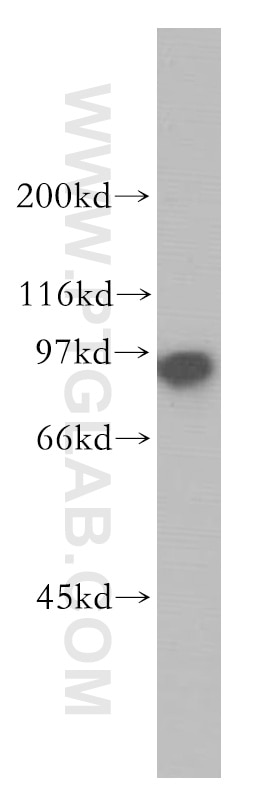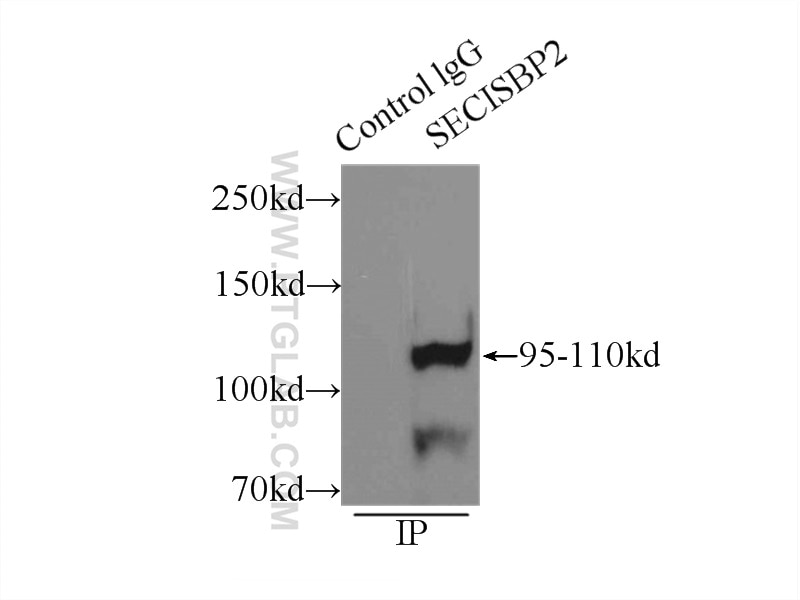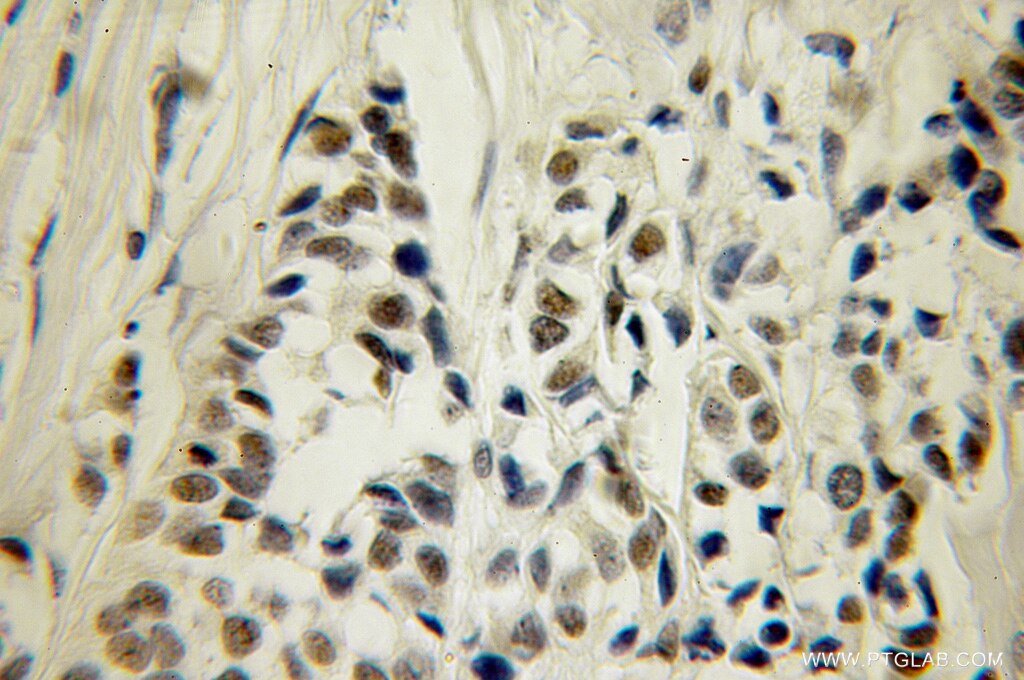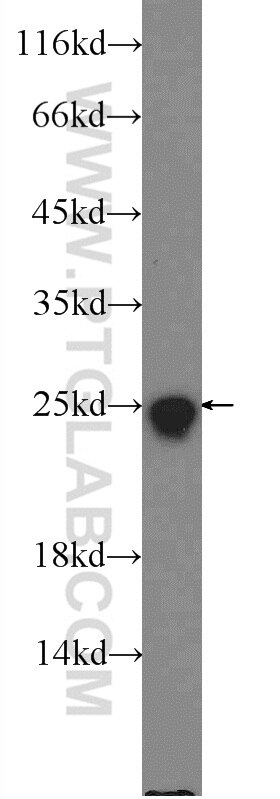- Featured Product
- KD/KO Validated
SECISBP2 Polyklonaler Antikörper
SECISBP2 Polyklonal Antikörper für WB, IF/ICC, IP, ELISA
Wirt / Isotyp
Kaninchen / IgG
Getestete Reaktivität
human, Maus, Ratte und mehr (1)
Anwendung
WB, IHC, IF/ICC, IP, ELISA
Konjugation
Unkonjugiert
Kat-Nr. : 12798-1-AP
Synonyme
Galerie der Validierungsdaten
Geprüfte Anwendungen
| Erfolgreiche Detektion in WB | HeLa-Zellen, humanes Nierengewebe, Jurkat-Zellen |
| Erfolgreiche IP | Maushodengewebe |
| Erfolgreiche Detektion in IF/ICC | HeLa-Zellen |
Empfohlene Verdünnung
| Anwendung | Verdünnung |
|---|---|
| Western Blot (WB) | WB : 1:500-1:2000 |
| Immunpräzipitation (IP) | IP : 0.5-4.0 ug for 1.0-3.0 mg of total protein lysate |
| Immunfluoreszenz (IF)/ICC | IF/ICC : 1:20-1:200 |
| It is recommended that this reagent should be titrated in each testing system to obtain optimal results. | |
| Sample-dependent, check data in validation data gallery | |
Veröffentlichte Anwendungen
| KD/KO | See 6 publications below |
| WB | See 14 publications below |
| IHC | See 1 publications below |
| IF | See 4 publications below |
Produktinformation
12798-1-AP bindet in WB, IHC, IF/ICC, IP, ELISA SECISBP2 und zeigt Reaktivität mit human, Maus, Ratten
| Getestete Reaktivität | human, Maus, Ratte |
| In Publikationen genannte Reaktivität | human, Maus, Ratte, Zebrafisch |
| Wirt / Isotyp | Kaninchen / IgG |
| Klonalität | Polyklonal |
| Typ | Antikörper |
| Immunogen | SECISBP2 fusion protein Ag3541 |
| Vollständiger Name | SECIS binding protein 2 |
| Berechnetes Molekulargewicht | 854 aa, 95 kDa |
| Beobachtetes Molekulargewicht | 95 kDa |
| GenBank-Zugangsnummer | BC036109 |
| Gene symbol | SECISBP2 |
| Gene ID (NCBI) | 79048 |
| Konjugation | Unkonjugiert |
| Form | Liquid |
| Reinigungsmethode | Antigen-Affinitätsreinigung |
| Lagerungspuffer | PBS mit 0.02% Natriumazid und 50% Glycerin pH 7.3. |
| Lagerungsbedingungen | Bei -20°C lagern. Nach dem Versand ein Jahr lang stabil Aliquotieren ist bei -20oC Lagerung nicht notwendig. 20ul Größen enthalten 0,1% BSA. |
Hintergrundinformationen
Selenium (Se) is an essential trace element required for the biosynthesis of selenoproteins, and selenocysteine insertion sequence (SECIS) binding protein 2 (SECISBP2, or SBP2) represents a key trans-acting factor for the cotranslational insertion of selenocysteine into selenoproteins. Defects in SBP2 are a cause of abnormal thyroid hormone metabolism (ATHYHM) associated with a reduction in type II iodothyronine deiodinase activity. Mutations in this gene have been associated with a reduction in activity of a specific thyroxine deiodinase, a selenocysteine-containing enzyme, and abnormal thyroid hormone metabolism. Cells depleted of SBP2 have increased levels of ROS, which lead to cellular oxidative stress manifested as DNA lesions, stress granules, and lipid peroxidation, induction of caspase- and cytochrome c-dependent apoptosis, indicating that SBP2 is required for protection against ROS-induced cellular damage and cell survival.
Protokolle
| Produktspezifische Protokolle | |
|---|---|
| WB protocol for SECISBP2 antibody 12798-1-AP | Protokoll herunterladen |
| IF protocol for SECISBP2 antibody 12798-1-AP | Protokoll herunterladen |
| IP protocol for SECISBP2 antibody 12798-1-AP | Protokoll herunterladen |
| Standard-Protokolle | |
|---|---|
| Klicken Sie hier, um unsere Standardprotokolle anzuzeigen |
Publikationen
| Species | Application | Title |
|---|---|---|
Science SELENOPROTEINS. CRL2 aids elimination of truncated selenoproteins produced by failed UGA/Sec decoding. | ||
Nat Chem Biol Ribosome stalling during selenoprotein translation exposes a ferroptosis vulnerability. | ||
Nucleic Acids Res Identification of a novel endogenous long non-coding RNA that inhibits selenoprotein P translation. | ||
Free Radic Biol Med Selective up-regulation of human selenoproteins in response to oxidative stress. | ||
Endocrinology Thyroid Hormone Metabolism Defects in a Mouse Model of SBP2 Deficiency.
| ||
J Biol Chem Interplay between Selenium Levels, Selenoprotein Expression and Replicative Senescence in WI-38 Human Fibroblasts. |












